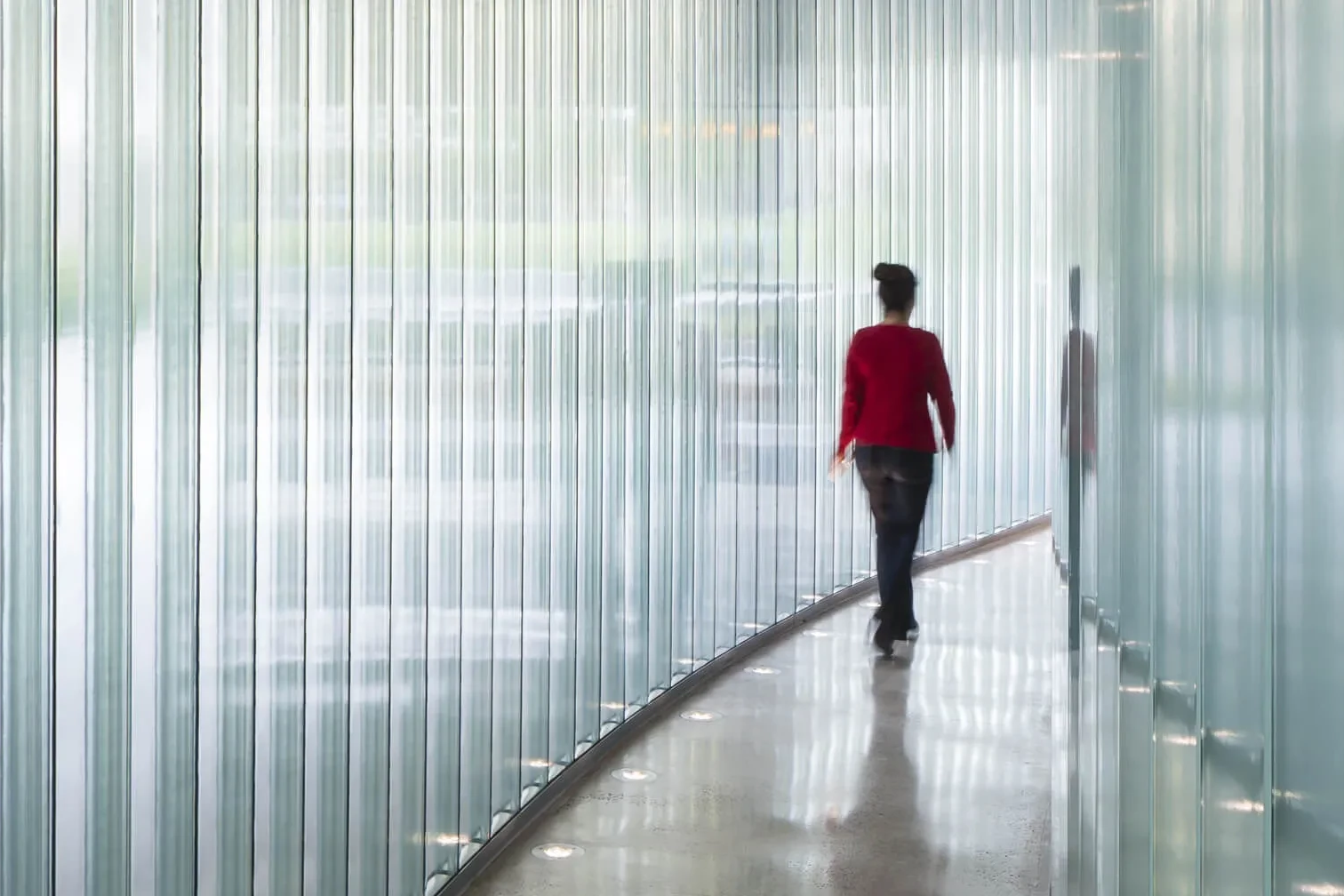Unlocking Creative Potential with Channel Glass
Devin Bowman, General Manager, Technical Glass Products

Channel glass designs have long been celebrated for their ability to spread out the sun’s rays as they pass through its translucent surface, creating evenly lit, glare-free spaces. But this architectural glass’ potential goes far beyond just illumination. In recent years, there has been a surge in exploring channel glass’ unique potential to create visually striking and innovative designs.
For designers, the magic of channel glass lies in its form. The self-supporting, U-shaped, linear cast glass channels’ seemingly simple design enables a wider range of configurations including curved and serpentine channel glass walls, unlocking a world of creative possibilities. Designers also experiment with textures and colors, pushing boundaries on what is possible on the interior as well as the exterior of buildings.
Pushing boundaries with channel glass design
Channel glass can be installed in impressive lengths—up to 23 feet for vertical applications and up to 13 feet for horizontal. These architectural glass configurations can help design teams achieve uninterrupted spans of glazing, perfect for building exteriors as well as grand entrances that want to balance style and substance.
Beyond linear applications, channel glass designs can create exciting, curved facades. The cast-glass channel’s slender frames and narrow segments can accommodate designs with tight radii—as low as 6 ft 6 in. These compact arcs can create dynamic curved and serpentine walls that add a touch of fluidity and organic movement to facades, partitions and walls. In such applications, the aluminum framing is stretch-formed into a radius. The channels are then segmented around the framing to achieve the desired configuration.
Channel glass designs can also enhance a building’s form through raked heads and sills. But what exactly is raked channel glass? In such applications, the cast-glass channels change elevation gradually across the width of the surface, allowing designers to create vertical applications with angles and curves such as trapezoids. To achieve this architectural glass design, all the glass channel segments are cut at an angle to fit the opening rather than just the inside corner to eliminate the risk of failure.
A great example of raked channel glass is the University of San Francisco’s John Lo Schiavo Center for Science and Innovation. Pilkington Profilit was used to animate and follow the curve of the building’s adjacent walkway, resulting in a unique corridor that stands out for its architectural brilliance. The combination of raked and curved channel glass heads and sills make the size and positioning of each channel glass piece unique and allow the façade to transition between curved and straight sections. In some instances, the linear glass channels step around architectural elements that intersect the walls at unusual angles.
To meet specific design needs, manufacturers can provide assistance with angled glass cuts and changes in dimensions, ensuring compatibility with the framework. As with any advanced configuration, early collaboration is key to achieving the desired outcome.
Interior vs exterior applications of channel glass
Channel glass applications can be integrated as single- or dual-glazed, based on project specifications like location, performance requirements and wind loads. For example, single-glazed channel glass, while popularly used in interior applications, can also be used as an exterior feature wall in cases where wind loads and energy efficiency are not a primary concern. Plus, unlike conventional systems that rely on bulky mullions and framing, single-glazed panels can be self-supporting in vertical installations. This allows design teams to create expansive, seamless light-transmitting surfaces that act as luminous tapestries.
Exterior applications most commonly call for dual-glazed channel glass systems. Because the glazing system becomes a part of the building envelope itself, the nesting channels are typically utilized in an overlapping manner. This configuration allows superior wind resistance, making dual-glazed channel glass a viable alternative to traditional curtain walls and storefronts. In projects where building performance is a priority, design teams can specify aerogel insulation, a 90 percent air-filled material in the gap between the nested channels. The lightweight and transparent insulation can reduce a channel glass’ solar heat gain coefficient to 0.31 and U-value to 0.19 with marginal impact on light transmissions.
Textures and colors enhance channel glass appeal
Beyond form, the vibrant palette and diverse textures of channel glass add another layer of design potential and functionality. Facades featuring intricately designed cast-glass channels textured with lines, waves and grooves not only offer visually captivating surfaces but also address the dual demands of natural light and privacy. A more complex textured channel glass surface disperses a higher quantity of light and obscures vision. In the same vein, channel glass with symmetrical and well-defined ridge textures also modifies color to create captivating optical effects.
The world of color in channel glass invites creative opportunities for artistic design ideas. Translucent, light-hued coatings add subtle hints of color, while a bold statement can be achieved with colored ceramic frits and high-performance color coatings. These fade-resistant options come in a wide spectrum of opaque and metallic hues with varying degrees of translucency, allowing design teams to perfectly complement or contrast a building's color scheme. Furthermore, advances in channel glass manufacturing now enable custom images and patterns, such as letters, logos, pictograms and motifs to be integrated into the glass itself.
Leveraging the striking appeal of colored channel glass facades is the glamorous Hollywood Casino in Columbus, Ohio. Here, the metallic-coated, wave-shaped textured channel glass surface intensifies color and light, creating mesmerizing optical variations for casino visitors. The combination creates an exterior that sparkles gold in the daylight.
Channeling creativity
Channel glass proves to be a captivating visual element, imbuing the building's facade with a distinctive character. However, the true magic unfolds when backlighting is introduced. As daylight fades, channel glass can be transformed into a radiant beacon, bathed in a soft, ethereal glow. This featured effect, as exemplified at the LAX Bradley International Terminal, creates a dynamic user experience. In this project, the backlit walls alternate between bright pinks, lime greens and blues to transform the space. The self-supporting “U”- shape profile of the channels created an interior cavity in which the colored lights were easily set.
Learn more about TGP’s Pilkington Profilit™ translucent channel glass system used in the project. For design support and resources, contact a channel glass supplier.



 Devin Bowman is General Manager of Technical Glass Products (TGP) and AD Systems. With over 20 years of industry experience, Bowman is actively involved in advancing fire- and life-safety codes and sits on the Glazing Industry Code Committee (GICC).
Devin Bowman is General Manager of Technical Glass Products (TGP) and AD Systems. With over 20 years of industry experience, Bowman is actively involved in advancing fire- and life-safety codes and sits on the Glazing Industry Code Committee (GICC).